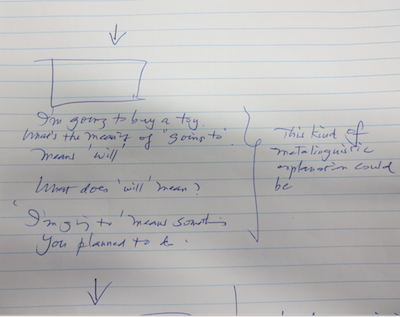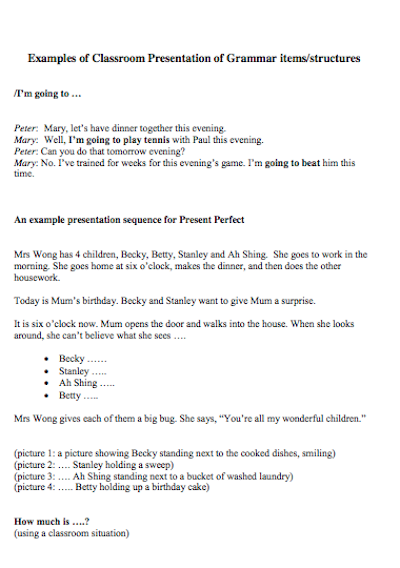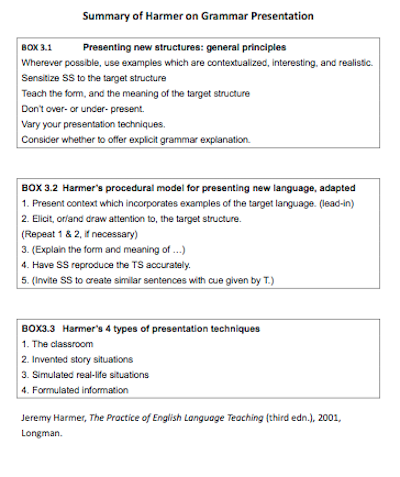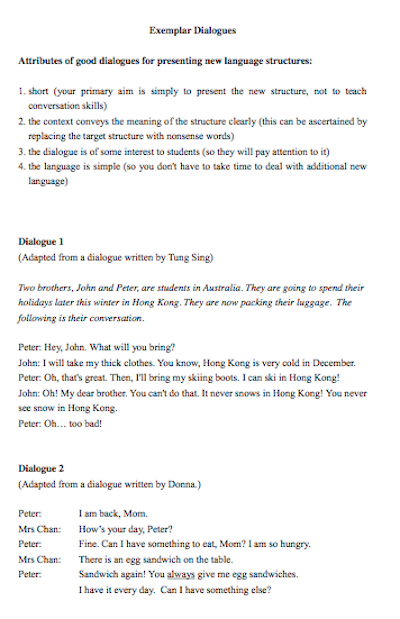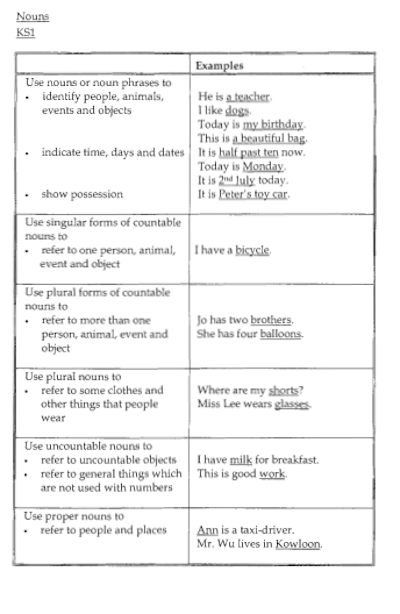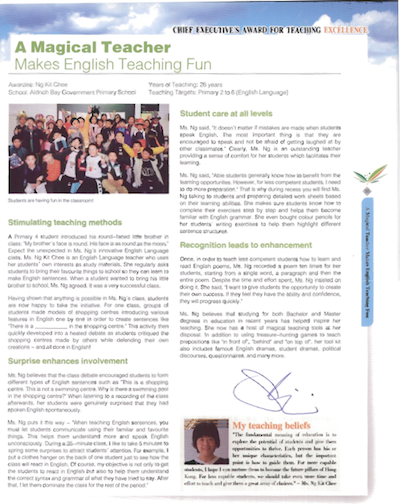Presenting a New Grammar Item
Objective: To set out various techniques for presenting a new grammar item.
Watch the following pre-class video, and then do the quiz. Please note the deadline for completing the pre-class Quiz.
Thinking about Grammar
Step 1:
Do this in pairs. Open the following image file. It is an extract from the tutor’s lesson observation notes that he took while observing a lesson on ‘Going to’.
Imagine that the class concerned was P.4. Discuss with your pair, exchanging thoughts on the teacher’s method for presenting ‘Going to’.
To you, what, if any, is the difference between going to and will?
Step 2:
Open a WORD file. Write 2 sentences to illustrate going to and will. Save the file using both your names as the filename (e.g., John & Mary). Then put it in the class folder specified by the tutor.
Understanding Grammar Items
Traditional grammar teaching often occupied itself with language form only, for example, the form of the Present Perfect tense, Passive Voice, Question tags, etc.
If we treat grammar as a resource for communication rather than a constraint, we also need to think about the meaning, and sometimes even the function (what we use the grammar item for) expressed by a grammar item.
This activity will sensitize you to the form, meaning, and function of grammar items.
Do this in pairs. Open the following tasksheet. Complete the 4 tasks together. Save your answers as a new document, using both your names as the filename (e.g. John & Mary). Then put it in the folder designated by the tutor.
Identify New Language Items in a Coursebook Unit
Currently, each unit in a coursebook presents one or sometimes more than one grammar item. Hence, we need to be able to identify the new/target language item in a coursebook unit.
Open the following coursebook unit (P4, first term, unit 1). Skim through it and find the target language item/s. Then study how the target language item is/are presented.
Limitations of The Coursebook
Coursebooks often rely on metalinguistic explanation in presenting a new grammar item. But very often, these explanations suffer from the following setbacks:
- They often concentrate on language form only, and neglect the meaning and function of the target language item.
- They are often over-simplications or half-truths.
- They are difficult to understand because they are usually abstract.
- They are boring.
In other words, teachers cannot simply regurgitate the metalinguistic explanation in the coursebook, assuming that students will then “learn” the target language item.
Teachers have to design their own way of presenting a new language item, so that students will see the form, meaning, and sometimes, function, of the grammar item in question. Afterwards, they may use the coursebook explanation as a kind of consolidation.
The following 2 simulated extracts are taken from a P4 and S2 coursebook respectively. Both extracts are presenting the grammar item SHOULD. Study the 2 extracts. How accurate or useful are the explanations? Be prepared to share your views with the whole class.
Viewing Some Grammar Presentation Samples
View the following sample grammar presentations. Pay attention to the technique used in each case.
Sample 1: Adverbs of frequency (usually; sometimes; never; etc.)
(Note: The tutor has reservations about this particular technique. Nevertheless, this shows that there is a procedure that the teacher needs to go through in presenting a new language item.)
Sample 2: If-structure
In this example, the student teacher uses a video to present Type 1 conditional sentences.
Sample 3: Participle adjectives (boring; bored; interested; interesting; etc.)
In this example, teacher Janet Law presents example sentences containing participle adjectives through a series of pictures. You will find the sentences she uses on the last slide.
Critiquing a Grammar Presentation in Action
Watch a classroom vignette in which the teacher presents the Present Perfect tense. While the procedure is systematic, there are still problems with the process. View the video, which will be shown on the large screen. After the viewing, share your thoughts with the whole class.
Learning about Grammar Presentation Techniques
Step 1: Preparation
Use Resource AT for activity. Work in pairs. Student A will study techniques 1-6; Student B techniques 7-12.
Step 2: Peer coaching
When you have finished reading, choose 4 techniques to explain to your partner. Refer your partner to the example material on the handout if necessary, or write/draw on a piece of paper to help with your explanation.
Designing a Presentation of a Grammar Item
Step 1:
You are about to design a presentation of a grammar item. But first of all, read 4 more examples from the resource below:
Step 2:
Work in groups of 4. Open the coursebook unit below, and turn to page 6 where you will find 2 grammar items. Concentrate on the second item, “-er + than”.
Design a presentation of this grammar item. Then rehearse it with one student in the group acting as the teacher and the other three as students. Imagine you have a maximum of 3 minutes in the classroom.
Step 3:
Act out your presentation to the whole class.
To Explore Further
Summary of Harmer on Grammar Presentation
Sample Dialogues for Presenting New Grammar items
Short dialogues can be useful for presenting a new grammar item. They can easily create a context which otherwise would not be possible in the classroom (e.g., in the playground; at home). They can be easily written by the teacher, and livened up using humor or people students know.The following document contains 4 sample dialogues, written by the tutor, each of which presents a new grammar item.
Grammar items in the official Primary English curriculum
What are the grammar items to be taught in the primary school? For example, should Past Continuous tense and Type 2 conditional sentences be taught to primary students?This extract from the 2004 Primary English Curriculum sets out the grammar items to be taught in the primary school.
